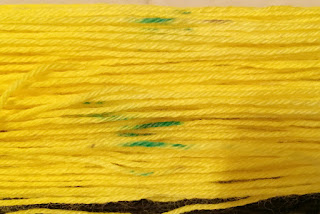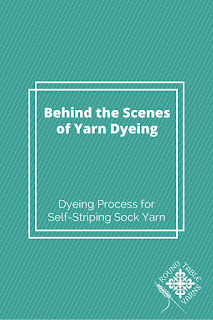Self-striping sock yarn has become pretty popular lately and quite a few indie dyers (myself included) offer it. It is a labor of love for those dyers who make it--although it takes a lot of work to dye it, it's so much fun to knit! Even using just a basic sock pattern, you can let the yarn do the work and still end up with a really neat pair of socks.
But what if you're not a sock knitter? At the fiber festivals I went to this year, quite a few people stopped to admire my self-striping sock yarn but moved along, saying, "I don't knit socks." But you don't have to move along. If you love self-striping sock yarn but have no idea what you'd make with it, I have some ideas for you.
Think about length of color repeats
The key with self-striping sock yarn is to think about the length of the color repeats. Most dyers make repeats long enough to knit somewhere from 3-8 rounds of a typically sized sock for one color. If you expand the circumference (or width) of a knitted item too far beyond that, the color repeats are going to come more quickly and won't give as much of a striped effect.For example, knitting a hat with self-striping sock yarn might work, but it also might mean each color shows up for just 1-2 rounds of the hat. Or, for example, if you try a triangular shawl that increases on each row, you'll find that the stripes don't work out evenly as you increase the number of stitches, and at some point you might end up with a stitch count that uses more than one color on just one row, completely losing the striped effect of the yarn. These options might work for you, but you'll have to experiment and take these projects on a case-by-case basis.
Use a smaller circumference similar to socks
The first thing you can do is make sure that the rounds in your project are a smaller size, similar to what you'd find with socks. One of my favorite patterns for this is Frankenfingers by Elizabeth Green Musselman. This pattern is for a pair of fingerless gloves--although fingerless isn't quite right as there are fingers; the fingers just don't have tips. Not only do you have the stripes going down the arm of the mitt, but think about the possibilities with the half fingers section: you could knit each one a different color within the self-striping yarn. And you could do each glove differently so they match because of the colors and stripes but have different colors along the fingers. So many possibilities!
Use a narrow width
If you'd prefer to knit something flat rather than in the round, you'll
want to keep the width of the item fairly narrow so as to make sure the
stripes have enough room to form. It doesn't have to be super narrow. A
typical sock has 64 stitches in a round, so as long as you don't go any
wider than that in a flat object, you should be fine. You could try a
simple garter stitch or stockinette stitch scarf. Or even a ribbed
scarf.But just because you should keep rows on the narrow side doesn't mean you're limited to a narrow finished object. Designer Frankie Brown has a series of "Ten Stitch" patterns that are based on knitting very narrow strips, but joining them in a way to create a much larger item, such as a blanket or a shawl (and joining as you go, not with seaming!). Self-striping sock yarn would be perfect for these patterns!
Ten Stitch Blanket
Ten Stitch Triangle
Ten Stitch ZigZag
Ten Stitch Corner
Knit on the bias
The main benefit of self-striping sock yarn is exactly in its name: it
allows you to create stripes without having to change yarn colors and
have tons of ends to weave in. So play with that property a bit by
trying a project that knits on the bias, which includes chevron
patterns.For example, I knit a Totally Biased cowl using Round Table Yarn Merlin in the Pavilion colorway. The way biased knitting works is that it forms rows at an angle, so it is perfect for showing off the stripes of self-striping yarn.
Biased knitting is also how chevrons are usually created. Just doing a Ravelry search for "chevron" led me to a ton of possibilities for patterns to use with self-striping sock yarn. Here are some of my favorites:
Chevron Sock Yarn Scarf by Amanda Gill (Amanda was my knitting instructor at my LYS back in Indiana!)
Chevron Scarf by Joelle Hoverson
ZickZack Scarf by Christy Kamm
Chevron Cowl by Shannon Sanchez
Waving Chevron Scarf by Lee Meredith
Work Mitered Squares
Another element that is often worked by changing colors of yarn is the
mitered square. Let the self-striping do the work for you and see what
magical possibilities the mitered square might open for you.For example, I knit a couple of mitered squares as examples (Round Table Yarns Merlin in Pavilion). You can make a ton of these and sew them together to make a blanket or scarf (there is also a way to join them as you go so you don't have to do any seaming). But I actually decided to make these into Christmas tree ornaments! (I wrote up some notes for what I did on my project page on Ravelry in case you'd like to make these yourself.)
But there are so many things you can do with mitered squares. Here are just a few of the possibilities:
Mitered Square Wrap and Shawl by O/C Knitiot Designs - Deby Lake
Mitered Square iPad Mini Case by Jocelyn Aufseeser
Mini Mochi Mitered Eyelet Shawl by Gail Tanquary
Polar Bear Express - Mitered Square Ornaments by Tess Mattos
Domino Star Stashbuster Afghan by Anita Grahn
Breakwater Shawl by Katherine Matthews
Other Ideas (Share Yours!)
There are lots of other ideas for using self-striping sock yarn that don't quite fit the above categories, such as the Barn Raising Quilt
(although technically it's a form of mitered square). Or you could even
just make a pom pom (which I also turned into a Christmas tree
ornament).And there were so many other pattern ideas that I saw that I didn't list here because I didn't want to overwhelm you with too many links (although I may have already done that).
So I'd like to invite you to the group bundle I've created over in the KarenDawn Designs/Round Table Yarns group on Ravelry. First, join the group if you haven't already. Once you're a group member, you can add patterns you find that work with self-striping yarn to the bundle. I can't wait to see your suggestions!
~~~~~~~~~~~~~~~~~~~
The content in this post was first featured in my newsletter (December 5, 2015). If you'd like to keep up to date on my designs and yarn and receive content like this right in your email inbox, make sure to subscribe to my newsletter.






























